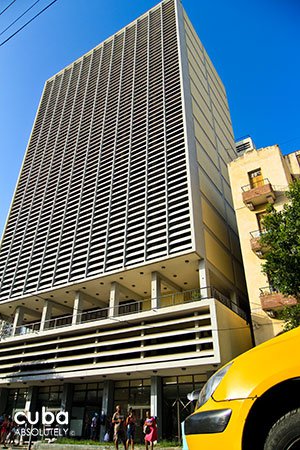In 1953, architect Antonio Quintana won the competition for the design of a building which would house doctors’ offices, stores and other public spaces. The use of brise-soleil, popularized by the French architect Le Corbusier and readily assimilated by Cuban architects and from other countries in the Americas, especially, Brazil, given its practical applicability in tropical climates for both shading and ventilation purposes, is an outstanding feature of this building. The brise-soleil here also offers an aesthetically pleasing appearance, which some experts claim was influenced by the skyscraper project designed by Le Corbusier for Algiers. The vestibule features El dolor humano, a mural painting by the Cuban painter Mariano Rodríguez. Today, the building is home to the Faculty of Economics of the University of Havana, as well as the Talía Theatre and the L Art Gallery, the latter two on the ground floor. The building was awarded Gold Medal by the National School of Architects in 1956.

Cristo de La Habana LH  4
4
This majestic representation of Jesus Christ, only four decades old, is part of the landscape that characterizes the entrance to the Havana harbor. It is 20 meters tall, weighs 320 tons and consists o …

Parque Lenin LH  4
4
Approximately 25 kilometers south of Havana is Parque Lenin, inaugurated on April 22, 1972 by Fidel Castro on the initiative of Celia Sánchez. The huge bust of Lenin, carved in 1982 by Soviet sculptor …
 Post 1959Open: 9am-5:30pm Wed-Sun except Jul-Aug 9am-5:30pm Tue-Sun100, esquina Cortina de la Presa
Post 1959Open: 9am-5:30pm Wed-Sun except Jul-Aug 9am-5:30pm Tue-Sun100, esquina Cortina de la Presa 
Gran Teatro de La Habana LH  4
4
Across from Parque Central, the Tacón Theater was inaugurated in April, 1838. At the time, this was Havana’s most important theater and arguably one of the best in the continent for its elegance, comf …
 EclecticAdmission: n-aPrado #458 e/ San Rafael y San José, Habana Vieja
EclecticAdmission: n-aPrado #458 e/ San Rafael y San José, Habana Vieja 
Casa de los Artistas LH  4
4
Several of Cuba’s most famous artists have their studios here, including Pedro Pablo Oliva, Zaida del Río and Roberto Fabelo. Contemporary art exhibitions are held on the ground floor.

Castillo de la Real Fuerza LH  4
4
History & architecture Considered an engineering marvel, this fortress on the plaza’s northeast corner is one of the oldest European defensive structures in the Americas, and the first built to gu …
 RenaissanceAdmission: CUC 2Open: 9:30am-5pm Tues-SunCuba e/ O’Reilly y Obispo, Habana Vieja
RenaissanceAdmission: CUC 2Open: 9:30am-5pm Tues-SunCuba e/ O’Reilly y Obispo, Habana Vieja 
Ciudad Deportiva LH  4
4
The Sports City was conceived as a complex that included race tracks; swimming pools; fields for different sports, including football; a small baseball stadium, and a coliseum at the forefront, which …
 ModernVía Blanca esquina a Boyeros
ModernVía Blanca esquina a Boyeros 
La Moderna Poesía LH  4
4
Owned by the López Serrano family–who evidently had a preference for Art Deco–this bookstore is a sample of how the sober interplay between lines and volumes can achieve a discreet elegance highligh …
 Art DecoAdmission: FreeObispo y Bernaza, Habana Vieja
Art DecoAdmission: FreeObispo y Bernaza, Habana Vieja 
Casa de Las Tejas Verdes LH  4
4
The Casa de Las Tejas Verdes (literally, House of the Green Tiles) was designed by architect José Luis Echarte and built in 1926. It is unique in Cuba for being the only example of the German renaissa …
 OtherAdmission: n-a2 # 308, entre 3ra y 5ta
OtherAdmission: n-a2 # 308, entre 3ra y 5ta 
Fundación Havana Club LH  4
4
One block southeast of Plaza de San Francisco, on Avenida del Puerto, stands the ochre-colored former mansion of the Conde de la Montera. Beyond its ornate doorway is a promotional center—the Museo de …

Factoría Habana LH  4
4
Factoría Habana is an experimental center for present-day artistic creation. The institution, which is ascribed to the City Historian’s Office, seeks to become a bridge between Latin American and Euro …





